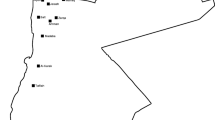Abstract
Objectives
To assess the upper body segment (US), lower body segment (LS) and US:LS ratio for children from birth to 18 y of age and to compare these data with other US:LS ratio norms from previously reported studies.
Methods
A cross-sectional, observational study was conducted in children [birth to 18 y; n = 5454 children (3158 boys)] residing in Pune city, Western India, from December 2015 through June 2017, to evaluate the US, LS and the US:LS ratio.
Results
The mean US:LS ratio in boys at birth was 1.45; at one year of age it was 1.35 that decreased to 0.89 at 14 y. The nadir for the US:LS ratio in boys was reached at 14 y of age (0.89). In girls, the mean US:LS ratio at birth was 1.44, at one year of age it was 1.35 that decreased to 0.89 at 12 y. The nadir for the US:LS ratio in girls was reached at 12 y of age (0.89). From 12 to 18 y the US:LS ratio was fairly constant (for girls: 0.89, for boys: 0.9). On plotting the US and LS against the age in present study population, the US and LS curves crossed each other (US:LS = 1) at 7 to 8 y in boys and at 6 to 7 y in girls.
Conclusions
The authors describe data for upper and lower body segments and their ratio in boys and girls from birth to 18 y in children from western Maharashtra. These data may help in the diagnosis of disproportionate short stature in children.


Similar content being viewed by others
References
Khadilkar V, Khadilkar A. Growth charts: a diagnostic tool. Indian J Endocrinol Metab. 2011;15:166–71.
Turan S, Bereket A, Omar A, Berber M, Ozen A, Bekiroglu N. Upper segment / lower segment ratio and armspan – height difference in healthy Turkish children. Acta Paediatr. 2005;94:407–13.
Dimeglio A. Growth in pediatric Orthopaedics. J Pediatr Orthop. 2001;21:549–55.
Yadav S, Dabas A. Approach to short stature. Indian J Pediatr. 2015;82:462–70.
Azhar MZ, Fadil RMR, Sahiratmadja EK. Upper lower segment ratio comparison between obese and normal children aged 7 to 10 years old. Althea Medical Journal. 2016;3:147–51.
Bogin B, Varela-Silva MI. Leg length, body proportion , and health: a review with a note on beauty. Int J Environ Res Public Health. 2010;7:1047–75.
Fredriks AM, van Buuren S, van Heel WJM, Dijkman-Neerincx RHM, Verloove-Vanhorick SP, Wit JM. Nationwide age references for sitting height, leg length, and sitting height/height ratio, and their diagnostic value for disproportionate growth disorders. Arch Dis Child. 2005;90:807–13.
World Health Organization. WHO child growth standards: measuring a Child’s growth. Geneva: WHO; 2008.
Khadilkar V, Yadav S, Agrawal K, et al. Revised IAP growth charts for height, weight and body mass index for 5- to 18-year-old Indian children. Indian Pediatr. 2015;52:47–55.
Tanaka C, Murata M, Homma M, Kawahara T. Reference charts of body proportion for Japanese girls and boys. Ann Hum Biol. 2004;31:681–9.
Kliegman RM, Jenson HB, Behrman RE, Stanton BF. Nelson textbook of Pediatrics,18th ed. Philadelphia: Saunders; 2007.
Wilkins L. The diagnosis and treatment of endocrine disorders in childhood and adolescence. Illinois: Springfield; 1966.
Pearson VV. Genetics. In: Gunn VL, Nechyba C, editors. The Johns Hopkins Hospital Harriet Lane Handbook, 16th ed. Toronto: Mosby; 2002. p. 277.
Contributions
All the authors were involved in study concept, planning, and design; SK, RL-O, PP: Acquisition of data; All the authors were involved in statistical analysis and interpretation of data, drafting and critical revision of the manuscript for important intellectual content. All authors have approved the final article. AVK will act as guarantor for this paper.
Author information
Authors and Affiliations
Corresponding author
Ethics declarations
Conflict of Interest
None.
Source of Funding
None.
Ethical Approval
All procedures performed in studies involving human participants were in accordance with the ethical standards of the institutional and/or national research committee and with the 1964 Helsinki declaration and its later amendments or comparable ethical standards.
Informed Consent
An informed written consent was obtained from all the parents/guardian of the participants included in the study.
Additional information
Publisher’s Note
Springer Nature remains neutral with regard to jurisdictional claims in published maps and institutional affiliations.
Rights and permissions
About this article
Cite this article
Kondpalle, S., Lote-Oke, R., Patel, P. et al. Upper and Lower Body Segment Ratios from Birth to 18 years in Children from Western Maharashtra. Indian J Pediatr 86, 503–507 (2019). https://doi.org/10.1007/s12098-019-02883-x
Received:
Accepted:
Published:
Issue Date:
DOI: https://doi.org/10.1007/s12098-019-02883-x




